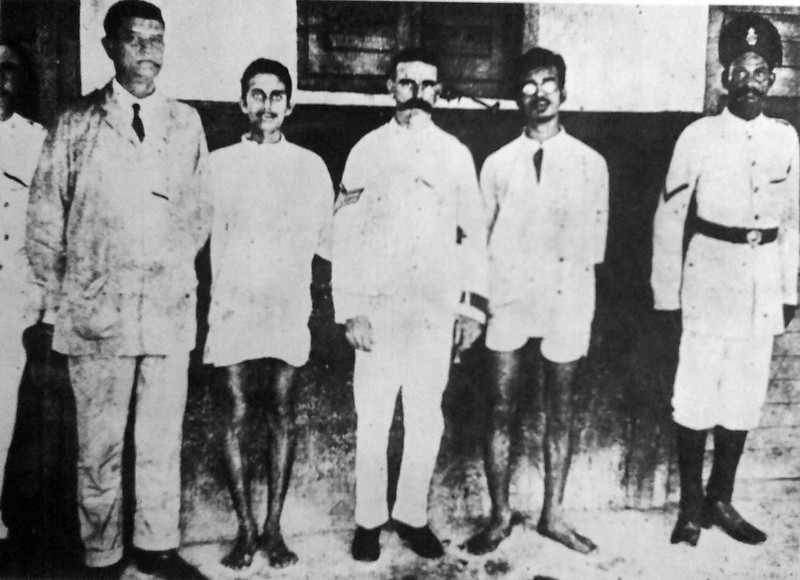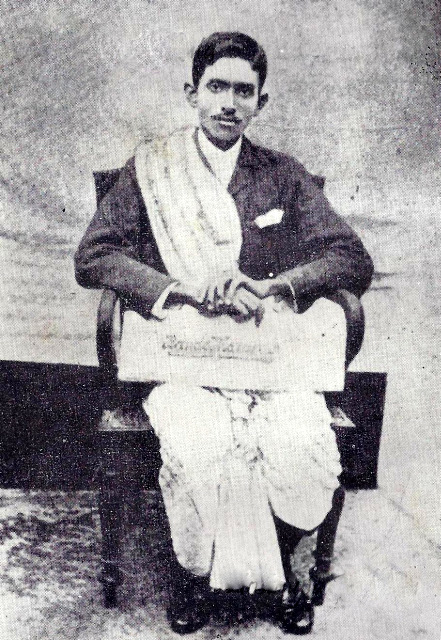Satyendranath Bose: A Leaf from Indian History
In the vast canvas of Indian history’s struggle for independence, where every stroke tells a story of courage, sacrifice, and the indomitable spirit of a people yearning for freedom, the tale of Satyendranath Bose emerges, not as a whisper, but as a clarion call that resonated through the hearts of many. It is critical at the outset to delineate the person of our focus: this Satyendranath Bose is not to be confused with the illustrious physicist bearing a similar name, who left an indelible mark on the field of quantum mechanics. Our narrative centers on a revolutionary, a freedom fighter whose lifeblood was infused with the fervor for India’s independence. On this day, November 21, the annals of history mark the death anniversary of Satyendranath Bose, a day that saw the loss of a valiant soul but also the birth of a legacy that would forever inspire the quest for freedom.
Unveiling the Revolutionary: Satyendranath Bose
In the twilight years of the 19th century and the early decades of the 20th, India found herself in the throes of colonial subjugation, a period marked by widespread unrest and a burgeoning desire for self-rule. It was against this backdrop of oppression and the ceaseless struggle for sovereignty that Satyendranath Bose’s story unfolded. Born into a nation under the yoke of British colonial rule, his life and actions were deeply influenced by the complex tapestry of India’s history, which saw an amalgamation of cultural, political, and ideological shifts over centuries of diverse rule. From the grandeur of ancient dynasties to the dark shadow of colonial exploitation, the stage was set for heroes to emerge from the embers of rebellion, and Satyendranath Bose stood among these titans, his convictions etched into the very soul of the freedom movement.
The Epoch of Rebellion and Resistance
As we delve into the life of Satyendranath Bose, we do so with the recognition of his unique contribution to India’s historic fight for independence. His journey from the scholarly pursuit of knowledge to the fierce battlefields of revolution offers a poignant reflection of a nation’s turbulent quest for freedom. On this solemn anniversary of his martyrdom, we explore the depths of his passion, the breadth of his influence, and the enduring significance of his sacrifice.
Satyendranath Bose: A Legacy Carved in History
Let us journey back to an era that shaped the destiny of a nation and forged the legacy of a patriot whose name, though shared with others of renown, stands distinct in the annals of Indian history as a beacon of resistance, resilience, and unwavering courage.
The Crucible of Colonialism: India under British Rule
The historical landscape of India, a vibrant tapestry stretching over eight centuries, is marked by the grandeur of imperial dynasties and marred by the oppressive regimes of colonial powers. It is against this complex backdrop of domination and resistance that the saga of Satyendranath Bose unfolds—a revolutionary whose aspirations and actions were deeply rooted in the quest for Indian autonomy and self-rule. This enduring desire for sovereignty, simmering in the hearts of Indians, was a direct response to the successive foreign dominions that shaped the socio-political fabric of the nation.
The Dawn of Nationalistic Fervor
As we delve deeper into the era of British colonial rule, it becomes apparent how this period catalyzed a profound nationalistic awakening among the Indian populace. The transition from the medieval grandiosity of the Delhi Sultanate and the Mughal Empire to British governance was not merely a change of rulers but a seismic shift in the cultural and political ethos of India. This era introduced new forms of governance, economic exploitation, and social stratification, which, in turn, ignited a widespread fervor to challenge and dismantle foreign dominion. It is within this cauldron of burgeoning nationalism and cultural upheaval that Satyendranath Bose’s revolutionary spirit was forged.
Satyendranath Bose: A Revolutionary Emerges
Amidst the strife and tumult of early 20th-century India, Satyendranath Bose emerged as a beacon of resistance against British colonialism. Born into the renowned Bose family, which had experienced firsthand the ebb and flow of India’s diverse rulers, Satyendranath was imbued with a rich legacy of cultural and ideological influences. These influences, coupled with the prevailing atmosphere of revolutionary zeal against British rule, shaped his path from an academic scholar to a fervent revolutionary. His life and actions are a testament to the significant impact of Indian history’s forces on individual destinies and the collective consciousness of a nation seeking freedom.
The Impact of Foreign Rule on Indian Society
The British colonial period was characterized by significant cultural and political shifts that deeply affected Indian society. The introduction of Western education, legal systems, and governance models brought about a profound transformation in Indian social structure, economy, and ways of thinking. However, these changes also sowed the seeds of discontent, as exploitative practices and racial discrimination became more prevalent. Analyzing the impact of foreign rule, it becomes evident how these conditions fostered a climate of resistance and nationalism among Indians. The cultural dissonance and economic grievances catalyzed a collective desire to reclaim autonomy and restore India’s sovereignty, laying the groundwork for revolutionary movements across the country.
Legacy of Satyendranath Bose
In the annals of India’s fight for independence, Satyendranath Bose stands out not just as a revolutionary but as a symbol of the indomitable spirit of a nation striving to break free from the chains of colonial rule. His life, set against the backdrop of India’s complex historical context, highlights the intrinsic link between the past and the aspirations of a people yearning for freedom. As we remember Satyendranath Bose, we pay homage to the countless unsung heroes of the independence movement, whose sacrifices paved the way for the India we know today—a nation proud, sovereign, and forever resilient.
Foundations of a Freedom Fighter: Early Life of Satyendranath Bose

The journey of Satyendranath Bose from a scholar to a revolutionary is a narrative rich with the influences of familial legacy, intellectual rigor, and a burgeoning sense of nationalism. Born into the esteemed Bose family of Bengal, Satyendranath’s early life was set against a backdrop of cultural wealth and intellectual pursuit. This section delves into the formative years of Bose, exploring the intricate weave of influences that propelled him onto the path of revolution.
Family Legacy and Cultural Milieu
The Bose family, renowned for its contributions to education, culture, and nationalistic activities, provided Satyendranath with an environment where intellectual curiosity and patriotic fervor were nurtured. His father, Professor Abhoy Charan Bose, was not just a figure of academic prominence but also a torchbearer of the spirit of independence that was gradually taking root in the hearts of the Indian populace. This familial atmosphere, imbued with discussions on freedom, justice, and self-rule, played a pivotal role in shaping Satyendranath’s ideological framework.
Satyendranath’s Educational Journey: Bedrock of Revolutionary Ideals

Influences and Inspirations of Satyendranath Bose: Catalysts for Change
Central to Satyendranath’s transformation were the figures who embodied the principles of resistance and self-determination. Among these were his uncle, Rajnarayan Bose, a prominent figure in the nationalistic movement, and the Ghose brothers, Aurobindo and Barindra, whose radical approach to India’s struggle for freedom left a lasting impression on him. Additionally, the literature and philosophy of the time, especially the works espousing Swaraj (self-rule) and Swadeshi (self-reliance), played a significant role in molding his revolutionary ethos.
The Emergence of Nationalistic Zeal
From an early age, Satyendranath was instilled with a deep sense of patriotism, nurtured through family values and academic exposure. The themes of nationalism and self-determination were not just abstract concepts but tangible ideals that he witnessed being championed by the society around him. His involvement in protests against the Partition of Bengal in 1905 marked the beginning of his active engagement in the freedom struggle. This period of his life illustrated how the seeds of nationalistic fervor, sown in the fertile ground of his youth, began to sprout into a steadfast commitment to India’s liberation.
The Making of a Revolutionary in Satyendranath Bose
Satyendranath Bose’s early life and influences depict the journey of a young man who, inspired by a rich tapestry of familial legacy, educational enrichment, and nationalistic fervor, embarked on a path that would forever intertwine his fate with the struggle for Indian independence. The themes of nationalism and self-determination, integral to his personal development, catalyzed his transformation from a scholar to a revolutionary, setting the stage for his indelible mark on the history of India’s freedom movement.
Satyendranath Bose: Revolutionary Path
The transition of Satyendranath Bose from an inspired student to a pivotal figure in India’s struggle for independence is a testament to his unwavering commitment to the cause of freedom. His involvement in the freedom movement, particularly within the Swadeshi Movement and various revolutionary efforts, showcases a period of intense activism and strategic engagements aimed at dismantling British colonial rule in India.
Swadeshi Movement: A Platform for Resistance
The Swadeshi Movement, sparked by the British decision to partition Bengal in 1905, served as a crucial battleground for Bose’s early revolutionary activities. This movement, advocating for the boycott of British goods and the promotion of indigenous products, became a symbol of economic independence and national pride. Satyendranath actively participated in Swadeshi campaigns, organizing protests, and spreading awareness about the importance of self-reliance. His efforts during this period were not merely acts of protest but strategic moves to weaken the economic foundations of the British regime in India.
Collaboration with Revolutionaries: Strengthening the Struggle
Bose’s revolutionary journey was marked by collaborations with other prominent figures in the freedom movement. His association with notable revolutionaries like Aurobindo Ghose and Barindra Kumar Ghose significantly influenced his ideological stance and tactical approach to the struggle against British rule. Together, they engaged in planning and executing acts of resistance, including the establishment of secret societies that aimed to mobilize youth for the cause of independence.
The Ananda Math: A Revolutionary Hub

Facing Ideological and Practical Challenges
Bose’s path was fraught with ideological and practical challenges. The decision-making process behind his revolutionary activities involved a constant balancing act between ideological purity and tactical pragmatism. One of the critical dilemmas he faced was the use of violence as a means to achieve political ends. The moral and ethical implications of such actions weighed heavily on Bose and his compatriots, prompting deep introspection about the most effective and justifiable methods for resisting colonial oppression.
The Broader Implications of Bose’s Actions

The strategic significance of Satyendranath Bose’s actions extended beyond immediate impacts. His efforts contributed to a growing sense of national consciousness and unity among Indians from diverse backgrounds. The Swadeshi Movement and other revolutionary endeavors played a crucial role in galvanizing public opinion against British rule, laying the groundwork for subsequent phases of the freedom struggle. Bose’s ability to blend ideology with action, and his commitment to the cause, inspired future generations of freedom fighters.
Legacy of Resistance
Satyendranath Bose’s involvement in the freedom movement illuminates the complex interplay between ideology and action in the context of colonial resistance. His contributions to the Swadeshi Movement and his collaborations with other revolutionaries highlight a period of dynamic and strategic activism. Through his revolutionary endeavors, Bose not only challenged the British colonial regime but also contributed to the shaping of a collective Indian identity that would eventually lead to the nation’s independence. His legacy is a reminder of the sacrifices and strategic foresight required to forge a path towards freedom.
Final Stand: Satyendranath Bose’s Legal Troubles and Martyrdom
Satyendranath Bose’s journey as a revolutionary, inevitably intertwined with acts of defiance against British rule, led him down a path fraught with legal troubles that culminated in his ultimate sacrifice. This section delves into the intricate web of legal challenges Bose faced, his martyrdom, and the profound legacy that ensued, reflecting on both the immediate and lasting impacts of his actions on the Indian independence movement.
Confronting the Empire: Legal Challenges
Bose’s revolutionary activities, characterized by his involvement in the Swadeshi Movement and leadership in clandestine societies, attracted the scrutiny of the British colonial authorities. His arrest and subsequent legal battles were emblematic of the British strategy to suppress the burgeoning tide of Indian nationalism. Convicted under the draconian laws tailored to quell dissent, Bose’s legal troubles highlighted the broader context of British responses to Indian revolutionaries. These responses were not merely punitive actions but part of a systematic effort to dismantle the networks of resistance that threatened the colonial regime.
Path to Martyrdom: A Symbol of Sacrifice
The circumstances leading to Satyendranath Bose’s execution were a direct consequence of his unwavering commitment to India’s freedom. His involvement in revolutionary activities, particularly the assassination of a British informant, marked the culmination of his resistance against colonial oppression. Bose’s trial and the subsequent death sentence underscored the brutal lengths to which the British administration would go to maintain its grip on India. His execution on November 21, 1908, was not just the silencing of a revolutionary but served as a poignant symbol of the sacrifices made in the quest for independence.
Reflecting on Satyendranath Bose’s Legacy
The immediate aftermath of Bose’s martyrdom was marked by a wave of grief and anger that swept across Bengal and beyond. His sacrifice galvanized a generation of revolutionaries, instilling in them a renewed vigor to challenge British rule. The symbolism of Bose’s martyrdom—his transition from an intellectual to a freedom fighter willing to lay down his life for the nation—resonated deeply with contemporaries and future freedom fighters. It underscored the realization that the path to independence would be paved with the sacrifices of countless individuals who, like Bose, believed in the cause greater than their own lives.
Long-term Impact of Satyendranath Bose’s Death
In the long arc of history, Satyendranath Bose’s martyrdom transcended the immediate context of his execution, embedding itself into the collective memory of the Indian independence struggle. His life and ultimate sacrifice became a source of inspiration, a testament to the indomitable spirit of those who fought for India’s freedom. The legacy of Bose’s martyrdom contributed to a narrative of resistance that fueled the independence movement, serving as a beacon for future generations to draw strength and inspiration from.
Undying Flame of Freedom Ignited by Satyendranath Bose
The legal troubles and martyrdom of Satyendranath Bose illuminate the profound sacrifices entailed in the fight against colonial rule. His story is a powerful reminder of the cost of freedom and the resilience of those who dare to resist oppression. As we reflect on Bose’s legacy, we are reminded of the enduring spirit of the independence movement and the timeless significance of sacrifice in the pursuit of liberty. Satyendranath Bose’s life and death continue to inspire, embodying the essence of a struggle that, though fraught with challenges, ultimately paved the way for the dawn of a new era in Indian history.
Eternal Flame: Legacy and Contemporary Relevance of Satyendranath Bose
As the curtain falls on the saga of Satyendranath Bose, a revolutionary whose life was a testament to the struggle for India’s independence, we reflect on a legacy that transcends time. Bose’s story is not merely a chapter in the annals of history; it is a beacon that continues to illuminate the path for future generations. This concluding section explores the enduring legacy of Bose within the broader narrative of India’s freedom struggle and its significance in the contemporary landscape of global movements for liberty and self-determination.
Legacy of Satyendranath Bose: A Beacon for the Nation
Satyendranath Bose’s contribution to India’s independence is a narrative of sacrifice, courage, and unyielding commitment to the cause of freedom. Over time, his life and sacrifices have been commemorated in various forms, from memorials and documentaries to literature and public discourse, each serving as a reminder of his dedication to India’s liberation. Bose’s legacy is enshrined in the collective memory of the nation, inspiring subsequent generations to value the freedoms won through the sacrifices of countless individuals like him. His story is a poignant reminder of the price of freedom and the resilience required to achieve and sustain it.
Connecting to the Present: The Universal Quest for Freedom
The ideals and actions of Satyendranath Bose resonate far beyond the confines of time and geography, finding relevance in today’s world where struggles for freedom and self-determination continue to unfold. In an era marked by global challenges—from authoritarianism to social injustice—Bose’s life serves as a powerful example of the individual’s capacity to contribute to larger causes. His story encourages contemporary movements to persevere in their quest for justice and equity, emphasizing the importance of unity, strategic action, and moral courage in the face of oppression.
Lessons for Today: Drawing Strength from Satyendranath Bose’s Legacy
From the life and actions of Satyendranath Bose, several lessons emerge that are pertinent to contemporary struggles for freedom and self-determination globally. First, the importance of intellectual engagement and ideological conviction in underpinning effective activism. Bose’s transition from academia to active revolution underscores the significance of informed and principled resistance. Secondly, the value of sacrifice and resilience in achieving long-term goals. Bose’s willingness to lay down his life for the cause of independence highlights the sometimes necessary confluence of personal loss and collective gain. Lastly, the power of collective action and solidarity. Bose’s collaborations with other revolutionaries exemplify how unity and shared purpose can amplify the impact of resistance efforts.
Satyendranath Bose’s Legacy Unbound by Time
The legacy of Satyendranath Bose is a testament to the enduring spirit of the fight for freedom. It reminds us that the journey towards liberty and justice is fraught with challenges, requiring the collective resolve and sacrifice of those who dare to dream of a better world. As we navigate the complexities of contemporary societal struggles, Bose’s life and sacrifices offer a wellspring of inspiration and a reminder that the quest for freedom and self-determination is universal and timeless. In honoring his legacy, we reaffirm our commitment to the ideals of liberty, equality, and fraternity, ensuring that the flame of freedom continues to burn brightly across generations and borders.
Feature Image: Click here to view the image. [credit https://www.wikipedia.org]

Good – I should certainly pronounce, impressed with your site. I had no trouble navigating through all tabs and related info ended up being truly easy to do to access. I recently found what I hoped for before you know it in the least. Quite unusual. Is likely to appreciate it for those who add forums or something, web site theme . a tones way for your client to communicate. Excellent task.